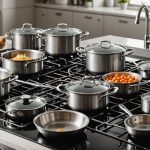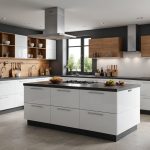Creating a kitchen that is accessible for individuals using a wheelchair or those with mobility challenges is not just a matter of convenience; it is essential for fostering independence and ensuring safety. The design of a kitchen can significantly impact the ease with which daily tasks are executed, from cooking to cleaning and storing items. As awareness grows about the needs of people living with disabilities, many are seeking ways to make their cooking spaces more inclusive.
Whether you are adapting your current kitchen or designing a new one, there are numerous considerations and modifications that can help make your kitchen more functional and welcoming. In this article, we delve into practical, implementable strategies that will transform your space into one that is truly accessible for everyone. From adjusting worktop heights to incorporating efficient aids, we will guide you through the process of creating a kitchen that maximizes space and minimizes barriers.
Also to discover : How do I choose the right kitchen lighting fixtures for mood and functionality in the UK?
Understanding the Essentials of Accessible Kitchen Design
When designing a kitchen for individuals with mobility challenges, the primary objective is to ensure that all areas and functions of the kitchen are within reach and easy to use. To achieve this, it is crucial to understand the fundamental principles of accessible kitchen design.
Prioritizing Space and Layout
One of the foremost considerations is the space and layout of the kitchen. An open and uncluttered layout can significantly enhance mobility. Ensure worktops, cabinets, and appliances are arranged in a manner that allows for smooth navigation without obstacles. Worktop heights should be adjustable or set at a level that is comfortable for wheelchair users.
Additional reading : How can I make my UK kitchen environmentally friendly with eco-conscious materials?
Selecting the Right Fixtures and Appliances
Opt for appliances with accessible features, such as side-opening ovens or dishwashers that are raised off the floor. Lever-style faucets and handles, along with pull-out shelving, can make daily tasks easier and more convenient. Positioning worktops and sinks at varying heights, with knee clearance underneath, will offer flexibility and improve functionality.
Lighting and Flooring
Good lighting is essential in any kitchen but particularly so in an accessible one. Ensure that the kitchen is well-lit, with a combination of ambient and task lighting to aid visibility. Choose non-slip flooring materials to prevent accidents and provide stability.
Incorporating Safety Features
Safety is paramount. Install smoke detectors and accessible fire extinguishers within easy reach. Consider features like rounded edges on counters and insulated pipes under sinks to prevent burns or injuries.
By understanding these foundational elements of accessible kitchen design, you can begin to make informed decisions that will significantly enhance the usability and comfort of your kitchen for individuals with mobility challenges.
Tailoring Worktops and Storage Solutions
Worktops and storage solutions play a pivotal role in the functionality and accessibility of a kitchen. Designing these elements with care can make a significant difference in ease of use for individuals with mobility challenges.
Optimizing Worktop Height and Space
Worktop heights should be carefully considered to ensure they are accessible to wheelchair users. Adjustable worktops allow for customization, making them suitable for different users and activities. Ensure there is enough clearance underneath for wheelchair accessibility, and consider lowering the height of specific sections for tasks like food preparation.
Smart Storage Solutions
Storage solutions should be designed to reduce strain and improve access. Install pull-out shelves and drawers instead of traditional cupboards for easier reach. Consider using open shelving for frequently used items to eliminate the need for bending or stretching. Lazy Susans in corner cabinets can also enhance accessibility.
Utilizing Vertical Space
Maximize vertical storage space without compromising accessibility. Use high-quality lifts or pulldown mechanisms to access upper cabinets safely. This approach not only increases storage capacity but also maintains the airy feel of the kitchen.
Consideration of Innovative Aids
Incorporating aids like jar openers, slip-resistant mats, and electric can openers can make kitchen tasks more manageable. These small additions can have a significant impact on usability.
By carefully tailoring worktops and storage solutions, you can create a kitchen environment that is both practical and accessible, empowering individuals with mobility challenges to engage more independently in cooking and daily activities.
Budgeting and Financial Considerations for Accessible Kitchens
Creating an accessible kitchen can be a significant investment, but with careful planning and consideration of available resources, it can be made more affordable. Understanding the financial considerations involved in designing an accessible kitchen is crucial to avoid unnecessary expenses and maximize your budget.
Exploring Financial Aids and Grants
In the UK, various financial aids and grants are available to support home modifications for individuals with disabilities. Eligibility for grants, such as the Disabled Facilities Grant, can alleviate some of the financial burdens associated with making a kitchen more accessible. VAT relief is also applicable to certain modifications and equipment purchased for this purpose.
Prioritizing Essential Modifications
Focus on essential modifications that directly enhance accessibility, such as adjusting worktop heights, modifying storage solutions, and installing accessible appliances. This approach ensures that your investment goes towards the most impactful changes.
Cost-Effective Design Choices
Choose cost-effective materials and solutions that do not compromise on quality. Consider modular designs that allow for future adjustments without the need for significant overhauls. Off-the-shelf solutions may be more budget-friendly compared to custom options.
Planning for Long-Term Usability
While initial costs may be higher, investing in durable, high-quality materials and solutions can reduce long-term expenses. Ensuring that your kitchen is designed to accommodate future needs can prevent costly renovations down the line.
By being strategic about budgeting and exploring available financial aids, you can make the process of creating an accessible kitchen more manageable, ensuring that the space is both functional and financially sustainable.
Conclusion: A Kitchen for All
Transforming your kitchen into a space that is accessible and inclusive for individuals with mobility challenges is a rewarding undertaking. By focusing on design elements that prioritize usability and comfort, you create an environment where everyone can engage freely and confidently in cooking and other kitchen activities.
From optimizing worktop heights and storage solutions to incorporating smart aids, the modifications you implement will have a lasting impact on the daily lives of those using the space. Moreover, by exploring financial aids and making informed design choices, the task of modifying your kitchen can be both cost-effective and sustainable.
Ultimately, an accessible kitchen is more than just a practical necessity; it is a testament to inclusivity and empowerment. By creating a kitchen that is adaptable and accommodating, you foster a sense of independence, ensuring that the heart of the home is a welcoming space for everyone.
As you embark on this journey, remember that each change, no matter how small, contributes to a larger vision of accessibility and equality, making your kitchen a true haven for all.











